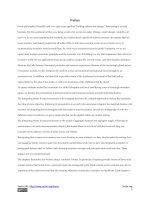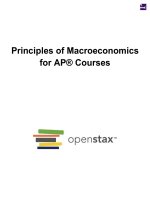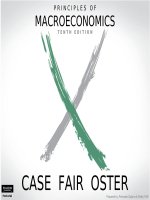Principles of macroeconomics 10e by case fair oster ch12
Bạn đang xem bản rút gọn của tài liệu. Xem và tải ngay bản đầy đủ của tài liệu tại đây (935.52 KB, 59 trang )
PRINCIPLES OF
MACROECONOMICS
PART III The Core of Macroeconomic Theory
TENTH
EDITION
CASE FAIR OSTER
© 2012 Pearson Education, Inc. Publishing as Prentice Hall
Prepared by: Fernando Quijano & Shelly
1 ofTefft
59
PART III The Core of Macroeconomic Theory
© 2012 Pearson Education, Inc. Publishing as Prentice Hall
2 of 59
Aggregate
Demand in the
Goods and Money
Markets
12
CHAPTER OUTLINE
Planned Investment and the Interest Rate
Other Determinants of Planned Investment
Planned Aggregate Expenditure and the Interest Rate
Equilibrium in Both the Goods and Money Markets:
The IS-LM Model
PART III The Core of Macroeconomic Theory
Policy Effects in the Goods and Money Markets
© 2012 Pearson Education, Inc. Publishing as Prentice Hall
Expansionary Policy Effects
Contractionary Policy Effects
The Macroeconomic Policy Mix
The Aggregate Demand (AD) Curve
The Aggregate Demand Curve: A Warning
Other Reasons for a Downward-Sloping Aggregate Demand
Curve
Shifts of the Aggregate Demand Curve from Policy Variables
Looking Ahead: Determining the Price Level
Appendix: The IS-LM Model
3 of 59
PART III The Core of Macroeconomic Theory
goods market The market in which goods and services are exchanged and in
which the equilibrium level of aggregate output is determined.
money market The market in which financial instruments are exchanged and
in which the equilibrium level of the interest rate is determined.
© 2012 Pearson Education, Inc. Publishing as Prentice Hall
4 of 59
PART III The Core of Macroeconomic Theory
Planned Investment and the Interest Rate
FIGURE 12.1 Planned Investment Schedule
Planned investment spending is a negative function of the interest rate.
An increase in the interest rate from 3 percent to 6 percent reduces planned investment from I0 to I1.
© 2012 Pearson Education, Inc. Publishing as Prentice Hall
5 of 59
PART III The Core of Macroeconomic Theory
Reducing the interest rate, ceteris paribus, is likely to:
a.
Increase the level of planned investment spending.
b.
Decrease the level of planned investment.
c.
Shift the demand for money curve to the right.
d.
Shift the supply of money curve to the right.
© 2012 Pearson Education, Inc. Publishing as Prentice Hall
6 of 59
PART III The Core of Macroeconomic Theory
Reducing the interest rate, ceteris paribus, is likely to:
a.
Increase the level of planned investment spending.
b.
Decrease the level of planned investment.
c.
Shift the demand for money curve to the right.
d.
Shift the supply of money curve to the right.
© 2012 Pearson Education, Inc. Publishing as Prentice Hall
7 of 59
Planned Investment and the Interest Rate
Other Determinants of Planned Investment
The assumption that planned investment depends only on the interest
rate is obviously a simplification, just as is the assumption that
consumption depends only on income.
PART III The Core of Macroeconomic Theory
In practice, the decision of a firm on how much to invest depends on,
among other things, its expectation of future sales.
The optimism or pessimism of entrepreneurs about the future course
of the economy can have an important effect on current planned
investment.
Keynes used the phrase animal spirits to describe the feelings of
entrepreneurs, and he argued that these feelings affect investment
decisions.
© 2012 Pearson Education, Inc. Publishing as Prentice Hall
8 of 59
E C O N O M I C S I N PRACTI C E
Small Business and the Credit Crunch
PART III The Core of Macroeconomic Theory
We know how a firm’s
investment decisions
depend on the
interest rate.
In the recession of
2008–2009 some
firms—especially
small ones—were
discouraged from
investing, not by high
interest rates, but by
the general
unwillingness of
banks to lend them
money at all.
Bailout Missed Main Street, New Report Says
The Wall Street Journal
© 2012 Pearson Education, Inc. Publishing as Prentice Hall
9 of 59
Planned Investment and the Interest Rate
Planned Aggregate Expenditure and the Interest Rate
We can use the fact that planned investment depends on the interest
rate to consider how planned aggregate expenditure (AE) depends on
the interest rate.
Recall that planned aggregate expenditure is the sum of consumption,
planned investment, and government purchases.
PART III The Core of Macroeconomic Theory
That is,
© 2012 Pearson Education, Inc. Publishing as Prentice Hall
AE ≡ C + I + G
10 of 59
Planned Investment and the Interest Rate
PART III The Core of Macroeconomic Theory
Planned Aggregate Expenditure and the Interest Rate
FIGURE 12.2 The Effect of an Interest Rate Increase on Planned Aggregate Expenditure
An increase in the interest rate from 3 percent to 6 percent lowers planned
aggregate expenditure and thus reduces equilibrium income from Y0 to Y1.
© 2012 Pearson Education, Inc. Publishing as Prentice Hall
11 of 59
Planned Investment and the Interest Rate
Planned Aggregate Expenditure and the Interest Rate
The effects of a change in the interest rate include:
A high interest rate (r) discourages planned investment (I).
Planned investment is a part of planned aggregate expenditure (AE).
PART III The Core of Macroeconomic Theory
Thus, when the interest rate rises, planned aggregate expenditure
(AE) at every level of income falls.
Finally, a decrease in planned aggregate expenditure lowers
equilibrium output (income) (Y) by a multiple of the initial decrease in
planned investment.
© 2012 Pearson Education, Inc. Publishing as Prentice Hall
12 of 59
PART III The Core of Macroeconomic Theory
Fill in the blanks. A higher interest rate __________ planned
investment and causes planned aggregate expenditure to shift
___________.
a.
increases; upward
b.
increases; downward
c.
decreases; upward
d.
decreases; downward
© 2012 Pearson Education, Inc. Publishing as Prentice Hall
13 of 59
PART III The Core of Macroeconomic Theory
Fill in the blanks. A higher interest rate __________ planned
investment and causes planned aggregate expenditure to shift
___________.
a.
increases; upward
b.
increases; downward
c.
decreases; upward
d.
decreases; downward
© 2012 Pearson Education, Inc. Publishing as Prentice Hall
14 of 59
Planned Investment and the Interest Rate
Planned Aggregate Expenditure and the Interest Rate
Using a convenient shorthand:
PART III The Core of Macroeconomic Theory
r ↑→ I ↓→ AE ↓→ Y ↓
r ↓→ I ↑→ AE ↑→ Y ↑
© 2012 Pearson Education, Inc. Publishing as Prentice Hall
15 of 59
Equilibrium in Both the Goods and Money Markets: The IS-LM Model
An increase in the interest rate (r) decreases output (Y) in the goods market
because an increase in r lowers planned investment.
When income (Y) increases, this shifts the money demand curve to the right,
which increases the interest rate (r) with a fixed money supply.
PART III The Core of Macroeconomic Theory
We can thus write:
Y ↑→ M ↑→ r ↑
d
Y ↓→ M ↓→ r ↓
© 2012 Pearson Education, Inc. Publishing as Prentice Hall
d
16 of 59
PART III The Core of Macroeconomic Theory
Which of the following statements describes the relationship
between the goods market and the money market?
a.
An increase in money demand.
b.
An increase in money supply.
c.
A decrease in the interest rate.
d.
An increase in both the supply and the demand for
money.
© 2012 Pearson Education, Inc. Publishing as Prentice Hall
17 of 59
PART III The Core of Macroeconomic Theory
Which of the following statements describes the relationship
between the goods market and the money market?
a.
An increase in money demand.
b.
An increase in money supply.
c.
A decrease in the interest rate.
d.
An increase in both the supply and the demand for
money.
© 2012 Pearson Education, Inc. Publishing as Prentice Hall
18 of 59
PART III The Core of Macroeconomic Theory
Equilibrium in Both the Goods and Money Markets: The IS-LM Model
FIGURE 12.3 Links between the Goods Market and the Money Market
Planned investment depends on the interest rate, and money demand depends on aggregate
output.
© 2012 Pearson Education, Inc. Publishing as Prentice Hall
19 of 59
PART III The Core of Macroeconomic Theory
Which of the following is a link between the goods market and the
money market?
a.
Income has considerable influence on the demand for
money in the money market.
b.
The interest rate has significant effects on planned
investment in the goods market.
c.
Both a and b above.
d.
None of the above. The goods market and the money
market are not linked in the ways described above.
© 2012 Pearson Education, Inc. Publishing as Prentice Hall
20 of 59
PART III The Core of Macroeconomic Theory
Which of the following is a link between the goods market and the
money market?
a.
Income has considerable influence on the demand for
money in the money market.
b.
The interest rate has significant effects on planned
investment in the goods market.
c.
Both a and b above.
d.
None of the above. The goods market and the money
market are not linked in the ways described above.
© 2012 Pearson Education, Inc. Publishing as Prentice Hall
21 of 59
Policy Effects in the Goods and Money Markets
Expansionary Policy Effects
expansionary fiscal policy An increase in government
spending or a reduction in net taxes aimed at increasing
aggregate output (income) (Y).
PART III The Core of Macroeconomic Theory
expansionary monetary policy An increase in the money
supply aimed at increasing aggregate output (income) (Y).
© 2012 Pearson Education, Inc. Publishing as Prentice Hall
22 of 59
PART III The Core of Macroeconomic Theory
Which of the following policy changes would be considered
expansionary monetary policy?
a.
An increase in the money supply.
b.
An increase in net taxes.
c.
An increase in government spending.
d.
An increase in government borrowing.
© 2012 Pearson Education, Inc. Publishing as Prentice Hall
23 of 59
PART III The Core of Macroeconomic Theory
Which of the following policy changes would be considered
expansionary monetary policy?
a.
An increase in the money supply.
b.
An increase in net taxes.
c.
An increase in government spending.
d.
An increase in government borrowing.
© 2012 Pearson Education, Inc. Publishing as Prentice Hall
24 of 59
Policy Effects in the Goods and Money Markets
Expansionary Policy Effects
Expansionary Fiscal Policy: An Increase in Government Purchases (G)
or a Decrease in Net Taxes (T)
PART III The Core of Macroeconomic Theory
crowding-out effect The tendency for
increases in government spending to cause
reductions in private investment spending.
© 2012 Pearson Education, Inc. Publishing as Prentice Hall
25 of 59









